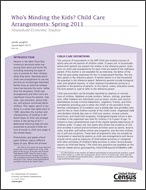Who’s Minding the Kids? Child Care Arrangements: Spring 2011
Who’s Minding the Kids? Child Care Arrangements: Spring 2011
Introduction
Parents in the labor force face numerous decisions when balancing their work and home life, including choosing the type of care to provide for their children while they work. Deciding which child care arrangement to use has become an increasingly important family issue as maternal employment has become the norm, rather than the exception. Child care arrangements and their costs are significant issues for parents, relatives, care providers, policy makers, and anyone concerned about children. This report, which is the latest in a series that dates back to 1985, describes the number and characteristics of children in different types of child care arrangements in the spring of 2011.1 Additional historical data are also presented to provide a fuller picture of trends in child care usage in the United States.
Preschoolers and grade school-aged children require different types of care. While the primary focus of child care for infants and preschoolers is meeting their basic needs, older children often engage in structured enrichment activities and are also found in self-care situations. The respective child care arrangements used for each age group are compared within this report. This report provides a full picture of child care patterns by providing data on child care arrangements that were used for any amount of time on a regular basis and primary child care arrangements, to represent child care arrangements that children spent the most time in on a regular basis during the survey period. Information is also provided about the cost of child care arrangements and the number of fathers providing care for their children.
_______________
1 The data in this report are from reference month four of the eighth wave of the 2008 panel of the Survey of Income and Program Participation (SIPP). Data for wave 8 were collected from January through April 2011. The population represented (the population universe) is the civilian noninstitutionalized population living in the United States.
Others in Series
Publication
Publication
Publication




